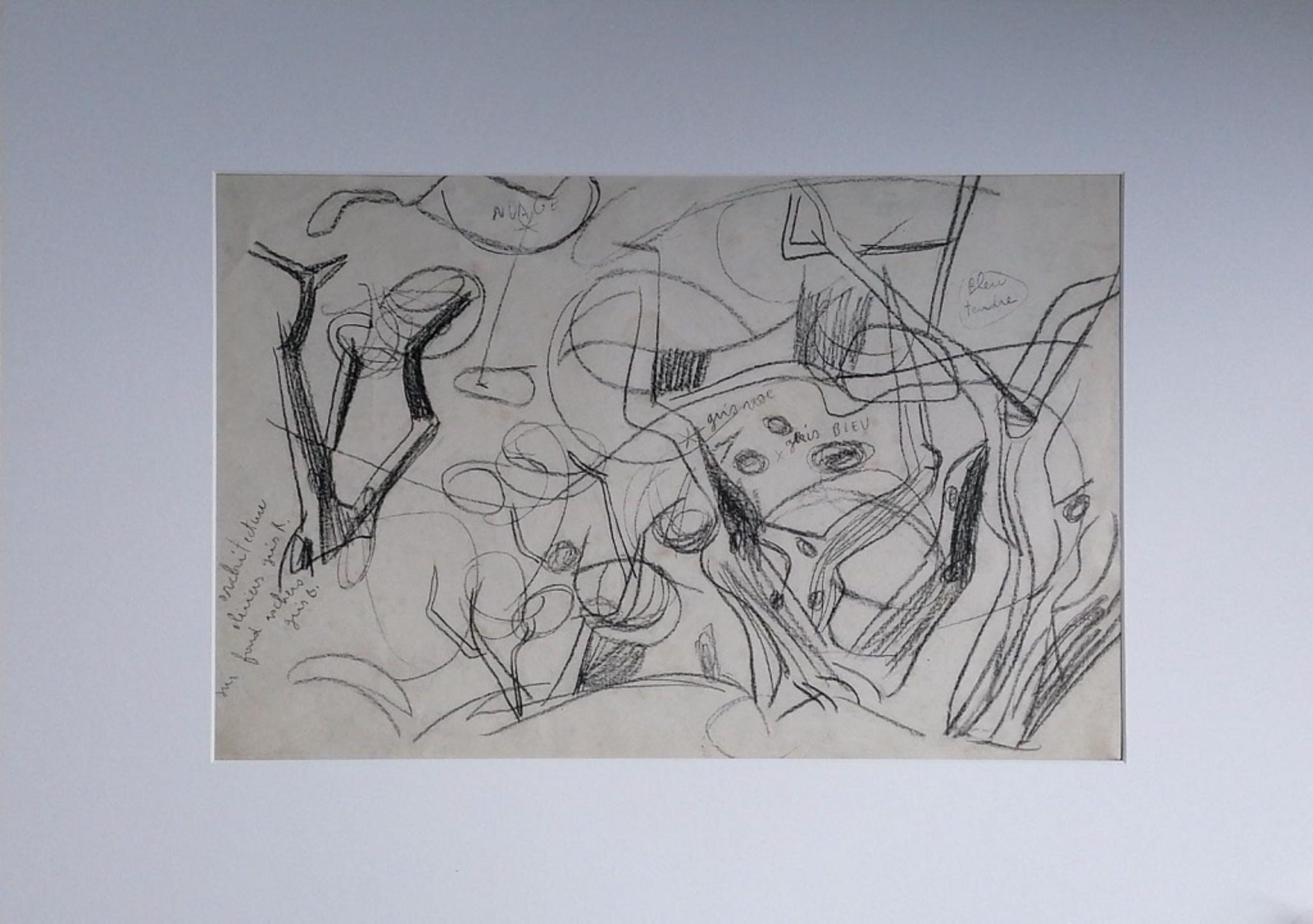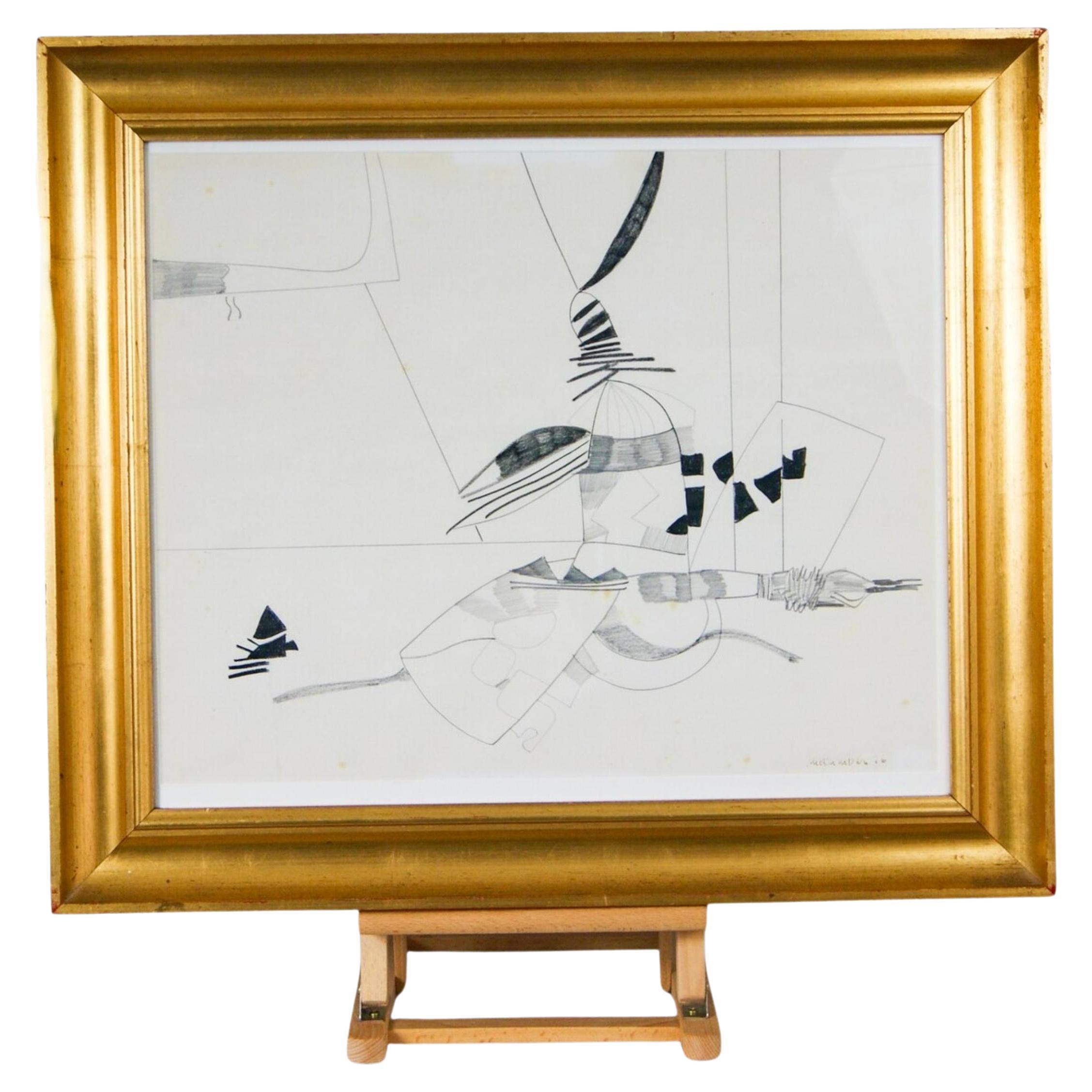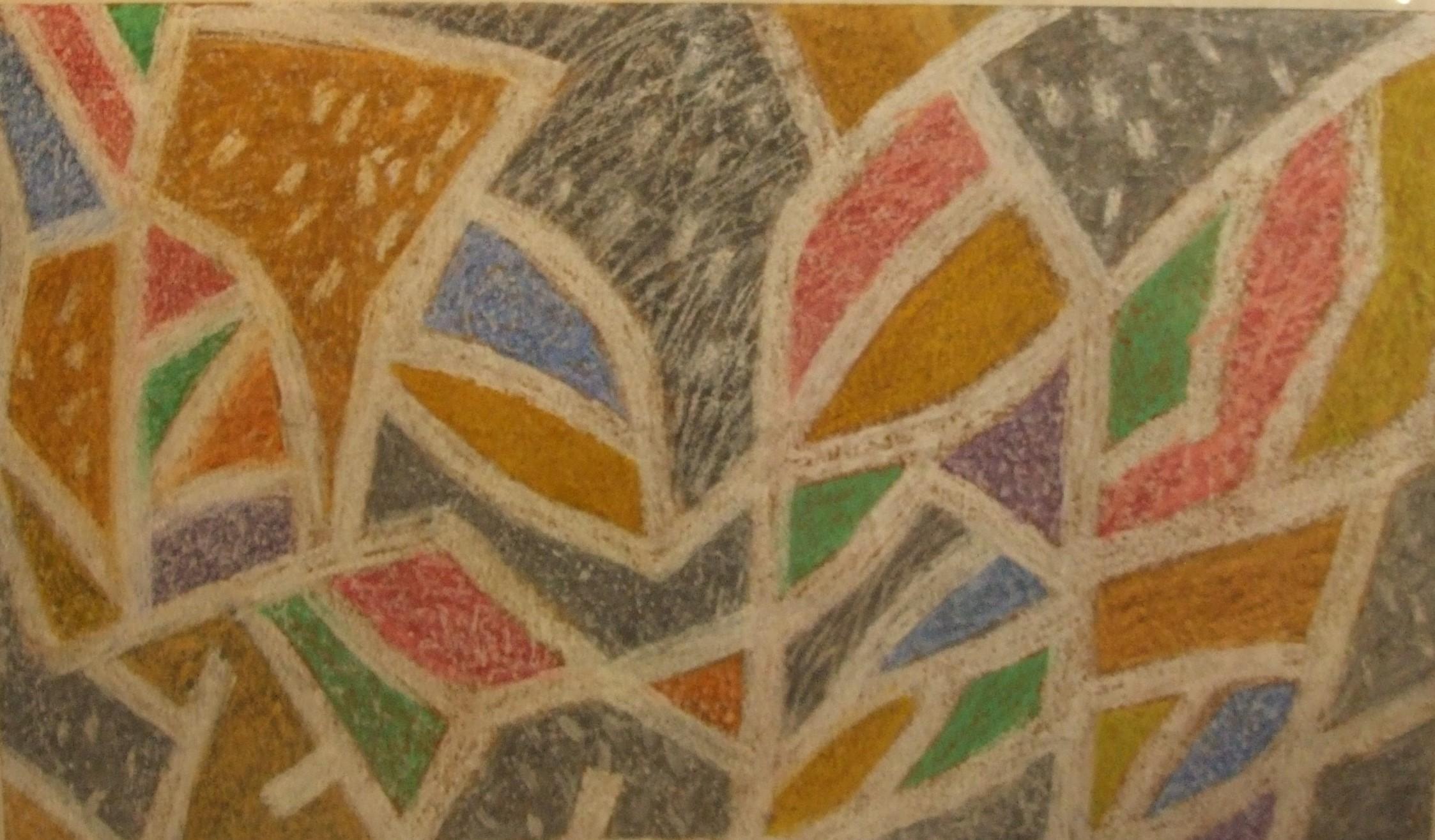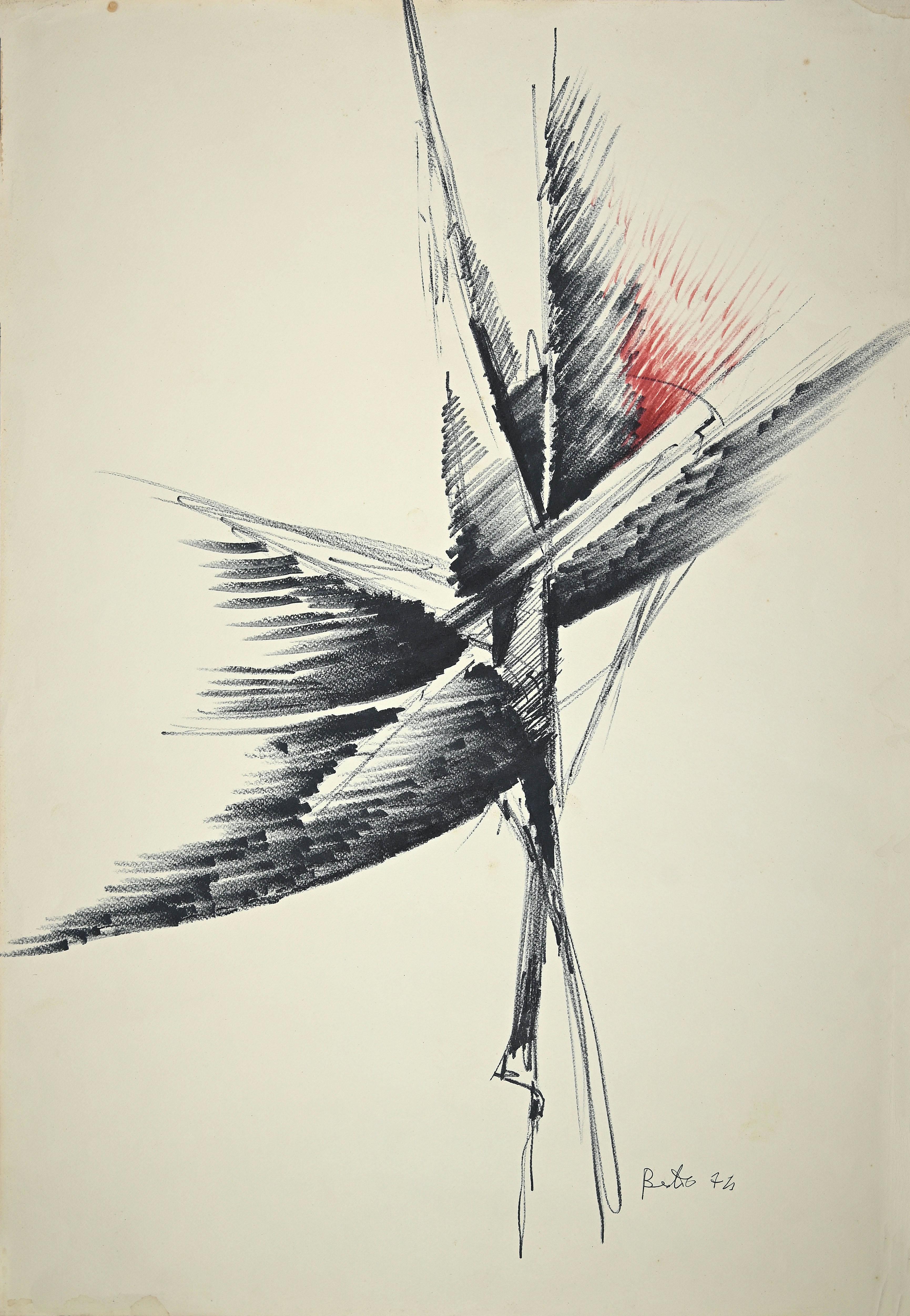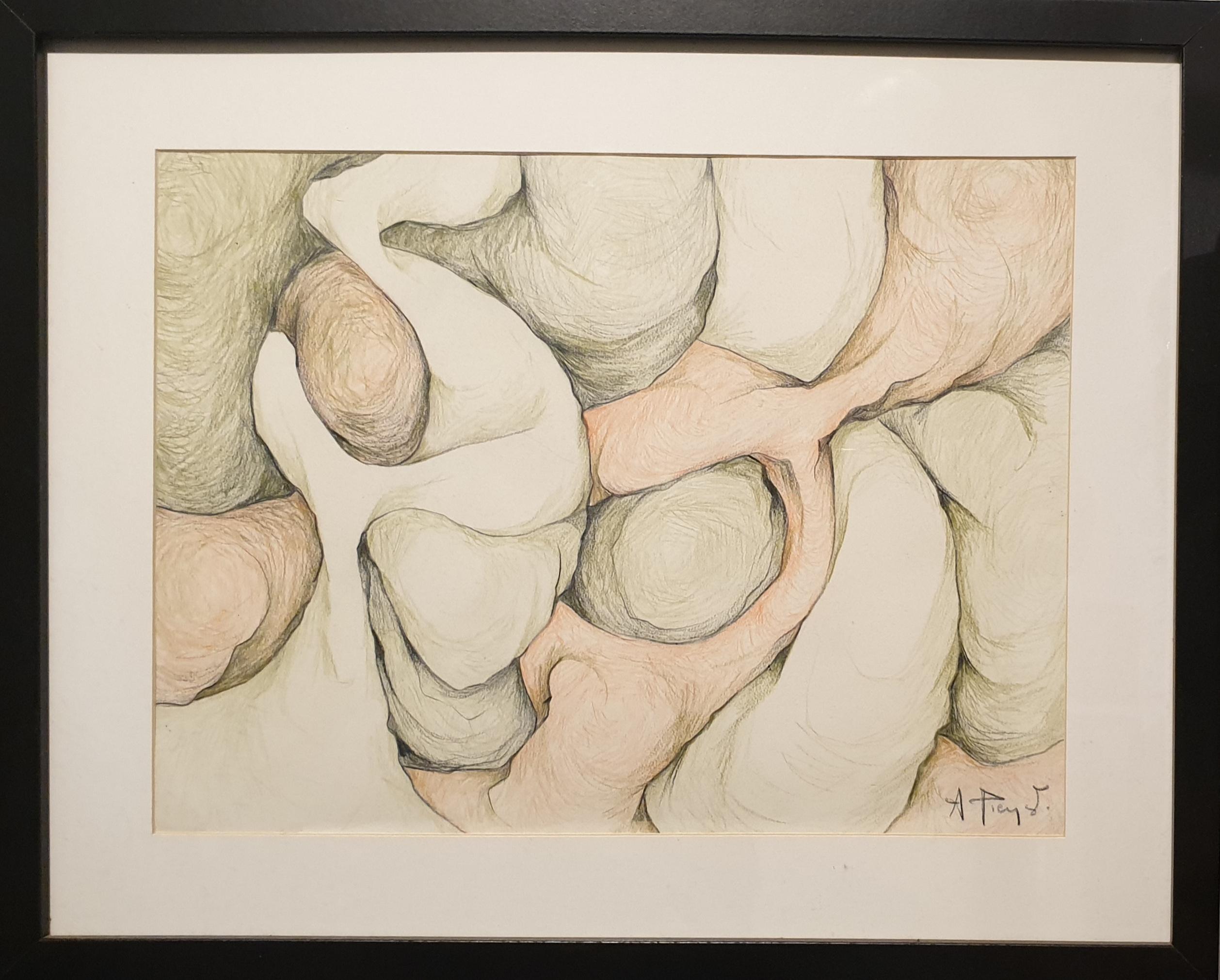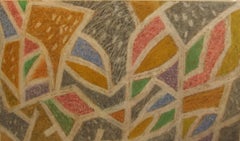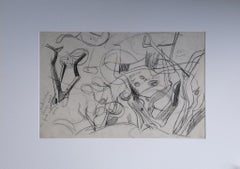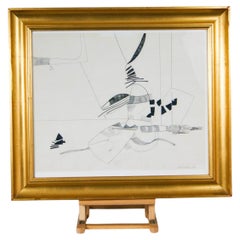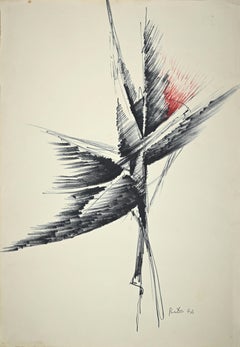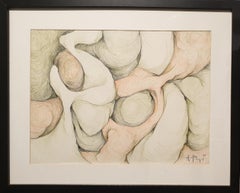Items Similar to Mouvement Spatiale, 1962 - crayon, 80x130 cm., framed.
Want more images or videos?
Request additional images or videos from the seller
1 of 6
Pierre DE MARIAMouvement Spatiale, 1962 - crayon, 80x130 cm., framed.1962
1962
$5,352.93
£3,988.10
€4,500
CA$7,510.11
A$8,251.45
CHF 4,255.22
MX$98,860.78
NOK 54,028.23
SEK 50,703.30
DKK 34,280.87
About the Item
He was born in Paris, the son of a conversation though open-minded middle-class family. His father runs the family business of optical equipment but he's also a theatre lover, an author and a poet. He gives his son a strict education and the boy will feel closer to his mother. Pierre De Maria will become a honest, straightforward man, uncompromising to himself and the others. He is very particular about his appearance and, as a child of the "Belle époque" takes up to a kind of dandysm.
A cousin of his, Jacques Camoreyt (a pupil of Albert Maignan) teaches him how to master pictorial techniques along with the rather academic education in Arts he is going through. From 1907 to 1914 he is a student at the Lycée Condorcet, first graduates in science and languages, then at the Engineering College just before World War 1.
The sight of atrocities will leave a deep scar in his memory. He has a miraculous escape from the war and finds a job in the family firm. He soon realizes he hates everything related to engineering and decides to launch on into painting. He works as a scene painter with Ronsin and Laverdet workshop and on stage with "avant-garde" drama companies. In the same time, he shows his work at the "Salon d'Automne" in 1923 an gets a honour prize in the modern painting department.
In 1925 he takes up to boxing and creates some polychromatic facades with Djo Bourgeois, then gets into the Art Deco trend as an architect and a decorator.
Henri-Pierre Roché, a writer (Jules et Jim) a painter and an art collector close to the cubists has already discovered talents ( Brancusi, Wols…) and takes an in interest in Pierre De Maria.
Autoportrait
Environ 1960
In 1926 (the "Années Folles "in Paris) Pierre De Maria meets Marcel Duchamp, Brancusi and the surrealist gang he enjoys but never joins. « They were friends and I was curious but I never liked the hint of complaisance I saw in their work. »
He then starts some technical research an collages as shown in his first exhibition of "pasted gouaches" in Princess'Murat 's gallery in Paris. (« Fermé la nuit »)
« I never thought I'd make money with my paintings. I took to painting as I would have taken holy orders »
He works as a journalist for Marianne and Vu magazines (1932-1933) and writes a detailed report about the Maelström in Norway and the soviet Movies. He has the opportunity to meet Eisenstein and Poudovkine in Sovietic Russia and thinks of making a name for himself in the Movie industry.
In 1939 Pierre De Maria meets Germaine Pellegrino who becomes his wife a year later. They'll have two sons : Jacques born 1942 and François born 1943. The family settle in Geneva at the end of 1943.
During those years he writes an unpublished autobiographical novel («Tir à volonté») as well as a collection of thoughts about various topics such as war. He also writes poems and a play (as his father had done) «Cornelius'death», in a rather humorous manner. « He who conveys the opinion of fools makes certain to get the majority of votes ».
In 1944 he is back in Paris, leaving his wife. He'll settle in Nice in 1953 and starts there his mechanical period with the recurrent theme of machinery in his painting.
In 1958 he has his second exhibition in Paris (JC de Chaudun's gallery) and shows a series of lino-engravings done after some drawings of his: he then begins being acknowledged by his contemporaries, his fellow-painters and the Parisian artistic circle.
Jacques Prévert even dedicated him a poem. («Les Machinoutis») Henri Pierre Roché, Henri-Pieyre de Mandiargues, Yves Taillandier contribute to the catalogue, well received by the press.
In the meantime, he has his works exhibited at the Salon d'Automne, the Salon de Mai, and the Salon Comparaison.
In 1963, Flemish wood-engraver Frans Masereel, and Professor Gowa, the curator of the Offenbach Fine Arts, both introduce Pierre De Maria successfully in Germany, allowing him to become famous abroad. The Homo Atomicus Exhibition gathers 45 paintings, recounting the artist'progress over the past ten years. He's then nicknamed the «Atomic age Hyperonymus Bosch» !
In 1964, Greek gallery owner Iris Clert finds him out and helps him into a new career. He is then 68. Iris Clert, as a specialist in Contemporary Art has contributed to the coming out of the New Realism movement through her most spectacular and mediatical exhibitions. She takes a fancy to Pierre De Maria 's work : « The visit of his studio turned my love at first sight into a cutainty : he uses the technique from the Ancients to express Future. » Afterwards, both get into intense collaboration so that the painter is allowed to use the gallery owner's european and international net.
In 1966, his work's dedicated a research published in Connaissance des Arts Magazine n° 70 : » A foreground study of Pierre De Maria in this month issue ». Later an article in International Art.
In 1969 he turns 73 and he can see his first retrospective exhibition in Nice at the Ponchettes Gallery (about 60 paintings).
At 76, he meets artist Hélène Bottet, from then on allowing humour to take over violence in his art. Machines don't frighten him anymore, he's now able to mock them even through they remain at the core of his paintings, in spite of the mechanical Art of the Twenties having long ago been left behind by its creators.
In 1974, Jean Selz writes a chapter about « machines and sandhills » in his book Le dire et le faire.
That very year, he gets the President of the Republic Prize at the International Art Salon in Toulon for the « Burst Head » (La Tête éclatée).
In 1980, Jean Roger Soubiran has a new retrospective of his works organized in Marseilles Contemporary Art Centre. He gathers over a hundred paintings. It will be his last personal exhibition : he is 84.
He dies in 1984, an old, secret, bright and educated person. His life was a poetical adventure, successively an engineer, an architect, a reporter, a writer, a dandy, a Don Juan. Most of all he devoted himself to making his art the ideal of a life freed of any dogma.
He has left about 450 works. They can be seen at the New York NOMA (1968), at the Teheran Museum (1969), at the National contemporary Art foundation in Paris (1968), at the Cannes Museum (1982) and at the Quebec Museum.
- Creator:Pierre DE MARIA (1896 - 1984)
- Creation Year:1962
- Dimensions:Height: 31.5 in (80 cm)Width: 51.19 in (130 cm)
- Medium:
- Movement & Style:
- Period:
- Condition:
- Gallery Location:Nice, FR
- Reference Number:1stDibs: LU52833356133
About the Seller
4.8
Vetted Professional Seller
Every seller passes strict standards for authenticity and reliability
Established in 1998
1stDibs seller since 2016
84 sales on 1stDibs
- ShippingRetrieving quote...Shipping from: Nice, France
- Return Policy
Authenticity Guarantee
In the unlikely event there’s an issue with an item’s authenticity, contact us within 1 year for a full refund. DetailsMoney-Back Guarantee
If your item is not as described, is damaged in transit, or does not arrive, contact us within 7 days for a full refund. Details24-Hour Cancellation
You have a 24-hour grace period in which to reconsider your purchase, with no questions asked.Vetted Professional Sellers
Our world-class sellers must adhere to strict standards for service and quality, maintaining the integrity of our listings.Price-Match Guarantee
If you find that a seller listed the same item for a lower price elsewhere, we’ll match it.Trusted Global Delivery
Our best-in-class carrier network provides specialized shipping options worldwide, including custom delivery.More From This Seller
View AllAbstract Composition EQ2, 1962 - crayon, 66x48 cm, framed
By Edmund Quincy
Located in Nice, FR
Fusain on paper, signed lower right.
Category
1960s Abstract Abstract Drawings and Watercolors
Materials
Crayon
Abstract Composition HG , 1980 - pastel, 82x122 cm., framed
By Henri Goetz
Located in Nice, FR
pastel on paper, signed lower right.
Henri Bernard Goetz (September 29, 1909 – August 12, 1989) was a French American Surrealist painter and engraver. He is known for his artwork, a...
Category
1970s Abstract Abstract Paintings
Materials
Pastel
Abstract Composition EQ1, 1962 - crayon, 66x48 cm, framed
By Edmund Quincy
Located in Nice, FR
Fusain on paper, signed lower right
Category
1960s Abstract Abstract Drawings and Watercolors
Materials
Crayon
Abstract composition WL2, 1960-65 - oil paint, 49x58 cm, framed
By Leo Wesel
Located in Nice, FR
Oil on canvas, signed lower right.
Category
1960s Abstract Abstract Paintings
Materials
Oil
Abstract Composition GA5, 1970 - oil paint, 60x40 cm, framed.
By Georges Arnulf
Located in Nice, FR
Oil on canvas, signed lower left.
Georges Gaston Arnulf est un peintre et graveur français, né à Monte-Carlo (Monaco) le 23 mars 1921 et mort le 19 novembre 1996 au Thillay.
Category
1970s Abstract Abstract Paintings
Materials
Oil
Abstract Composition S5, 1963 - oil paint, 82x65 cm
By Gérard Souzay
Located in Nice, FR
Oil on canvas, signed lower left
Gérard Souzay (né Gérard Marcel Tisserand le 8 décembre 1918 à Angers, Maine-et-Loire, et mort le 17 août 2004 à Antibe...
Category
Mid-20th Century Abstract Abstract Paintings
Materials
Oil
You May Also Like
Abstract Grey Composition - Original Pastel - 1970s
Located in Roma, IT
Abstract Grey Composition is an original contemporary artwork realized in the 1970s.
Original black pastel ontissue paper.
Passepartout is included (cm 49.5 x 69). Image Dimension...
Category
1970s Modern Abstract Drawings and Watercolors
Materials
Pastel
1970s Abstract Drawing Graphite on Paper by MILTON WILSON (American 1923-2004)
Located in Torquay, GB
Original abstract drawing, pencil and graphite on artist paper, in colours black and white, by Oregon born artist Milton Wilson.
This is part of a selection of 3 works marked Oct 76 ...
Category
Mid-20th Century American Mid-Century Modern Drawings
Materials
Paper
Abstract Composition - Original Pencil and Pen - 1974
Located in Roma, IT
Abstract Composition is an original drawing artwork in pencil and pen realized by an anonymous Italian artist in 1974.
Hand-signed and dated in pencil on the lower right.
Good cond...
Category
Late 19th Century Abstract Drawings and Watercolors
Materials
Pen, Pencil
Abstract Expressionist Biomorphic Coloured Pencil Drawing.
Located in Cotignac, FR
1980s abstract expressionist biomorphic coloured pencil drawing on paper by Belgian artist André Pierret, signed bottom right.
André Pierret was born ...
Category
1980s Abstract Expressionist Abstract Drawings and Watercolors
Materials
Paper, Carbon Pencil, Color Pencil
Untitled 1 - Expressive Charcoal On Paper Painting, Black White Drawing
By Krzysztof Gliszczyński
Located in Salzburg, AT
The paper of the work is not yellowed, there is a applied yellowed primer under the drawing
Krzysztof Gliszczyński is Professor for painting o...
Category
Early 2000s Conceptual Abstract Drawings and Watercolors
Materials
Paper, Charcoal
Abstract Composition - Pastel by Giorgio Zennaro - 1969
Located in Roma, IT
Oil Pastel on paper realized in 1969.
Hand signed and dated in pencil lower right.
Hand dedicated, signed and dated (1971) on rear.
Includes a wooden frame cm. 43.5x52.
Very goo...
Category
1960s Modern Abstract Drawings and Watercolors
Materials
Pastel
$847 Sale Price
25% Off
